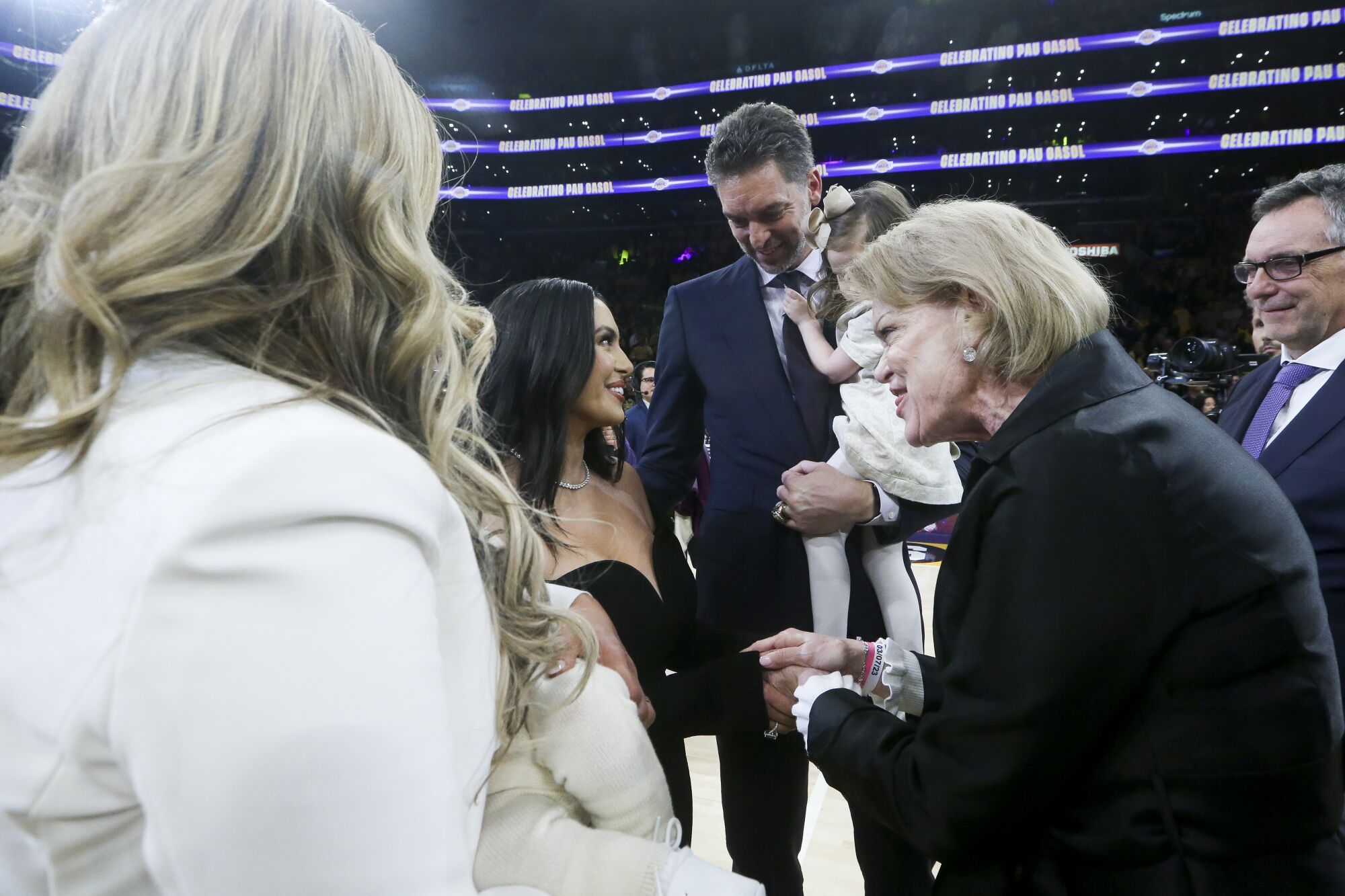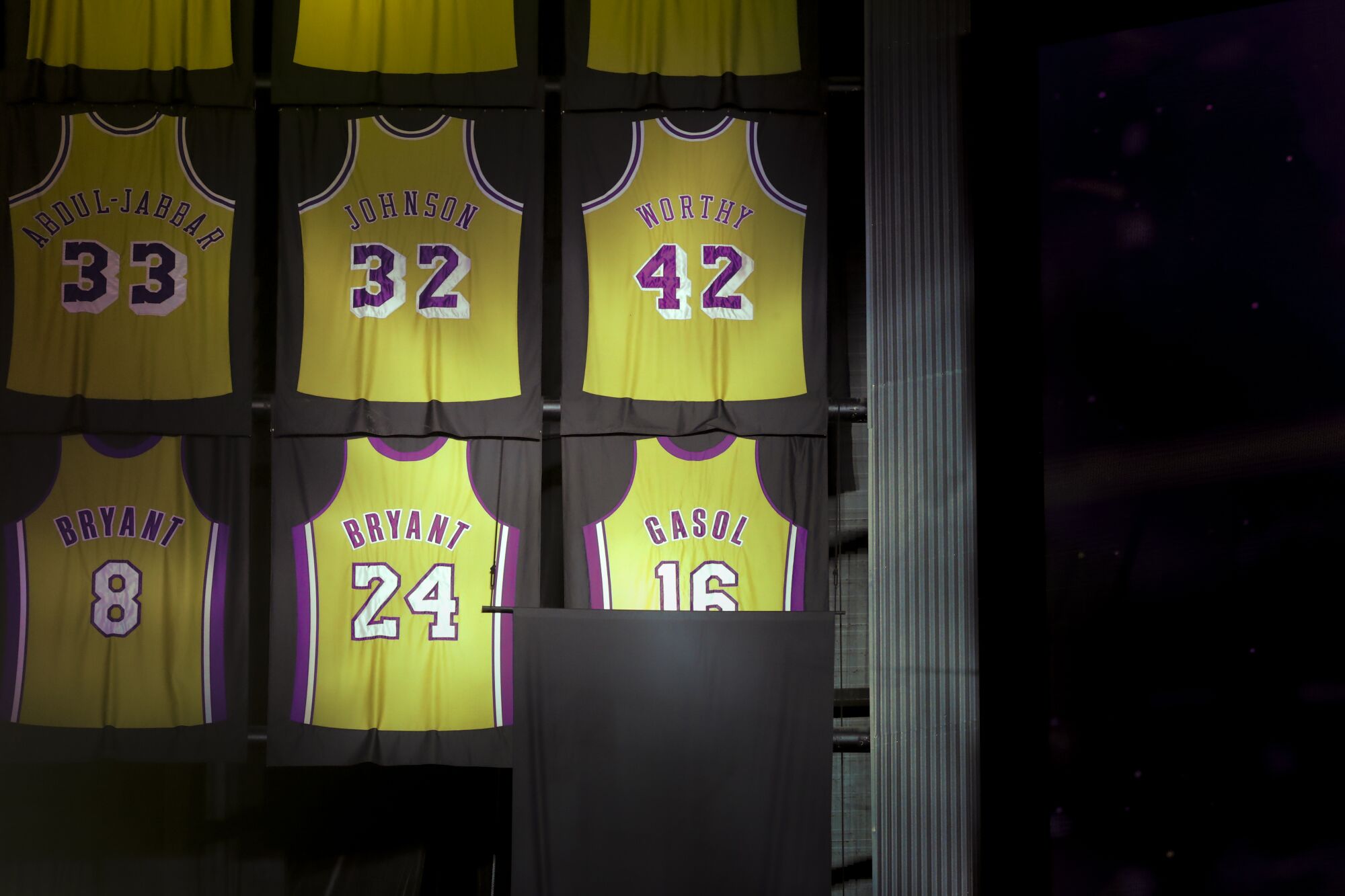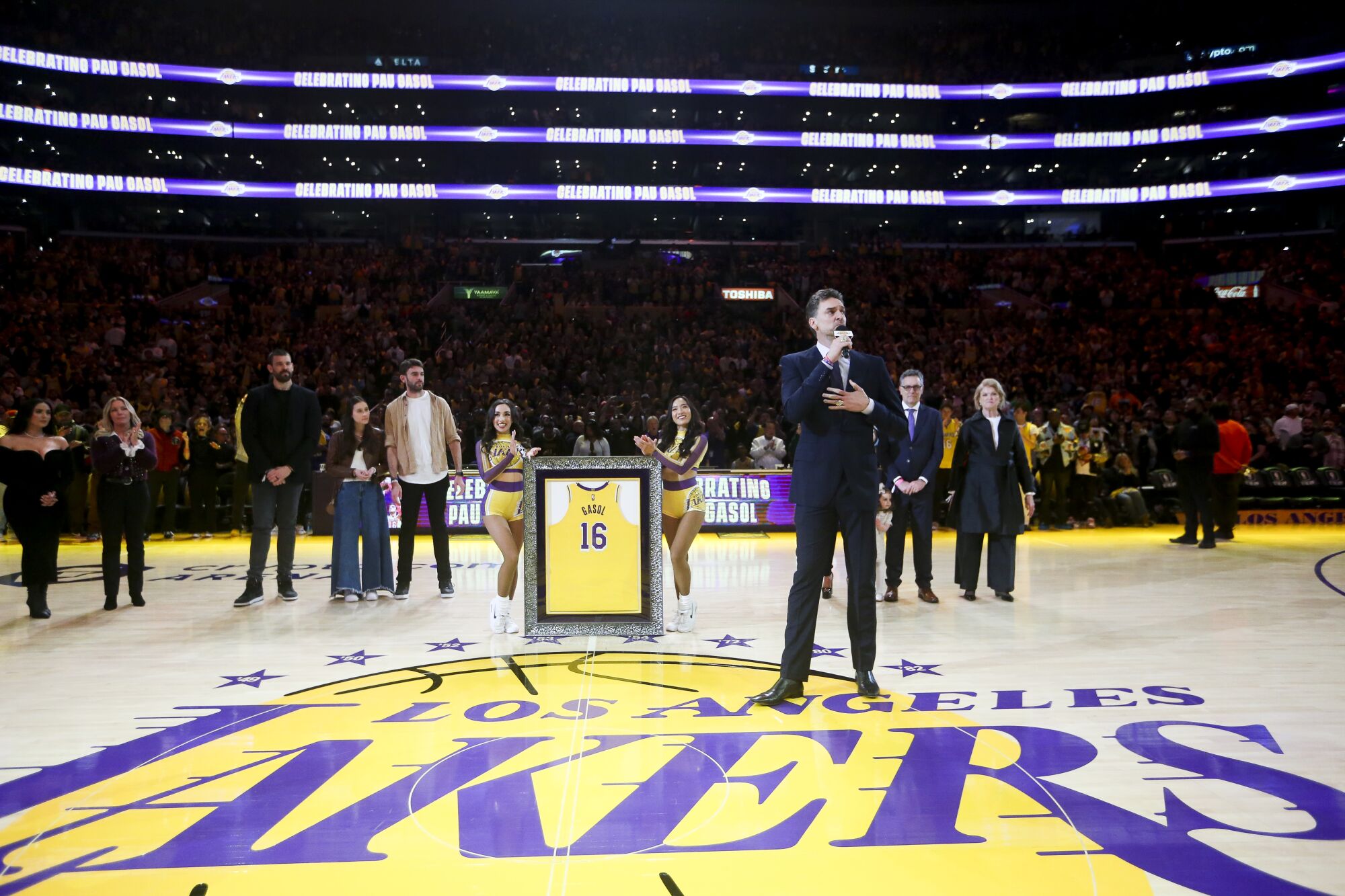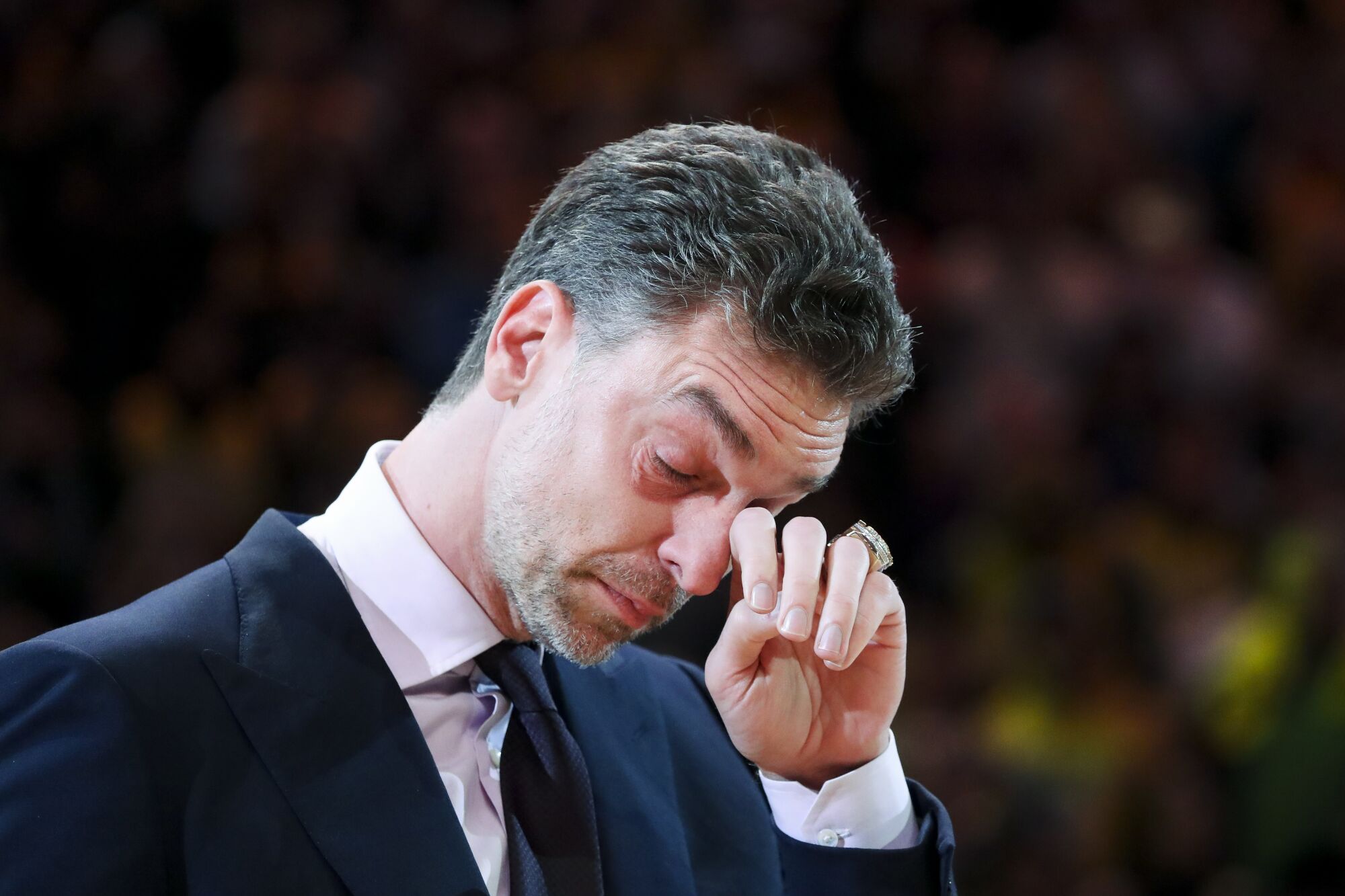Emotional Pau Gasol takes rightful place next to Kobe Bryant
He was the ultimate wingman, the best supporting actor, the perfect complement.
Pau Gasol spent his seven Lakers seasons in the shadow of Kobe Bryant, accepting crude challenges, absorbing trash talk, burying his own ego for the sake of elevating his far more famous colleague in creating two NBA championships.
Every Lakers fan knew Bryant wore No. 8 and No. 24. Few knew Gasol wore No. 16.
Until now. They know now. They’ll know forever. A stately reminder will hang in the Crytpo.com Arena rafters, where Gasol’s number was retired Tuesday night for the most unusual yet understandable of reasons.
He was Kobe Bryant’s greatest teammate. He used their synergy to contribute to three of their greatest seasons. Those three straight trips to the NBA Finals from 2008 to 2010 resulted in those two titles.

Pau Gasol holds onto his daughter Elisabet Gianna Gasol while speaking with Vanessa Bryant during his Lakers jersey retirement ceremony at halftime Tuesday night.
(Luis Sinco / Los Angeles Times)
Pau and Kobe are now a duo for eternity.
“Ko-be, Ko-be, Ko-be,” the fans chanted.
“Pau-Gasol, Pau-Gasol,” the fans chanted.
When Gasol’s jersey was unveiled in the arena rafters at halftime of the Lakers’ win over the Memphis Grizzlies, it slowly appeared next to a jersey belonging to Bryant. Standing at center court in a suit and two championship rings, Gasol wept.
“I’m just overwhelmed to see all the faces here,” Gasol said in his seven-minute speech. “But I can’t go on without talking about the person and the face that I don’t see. The brother that elevated me and … challenged me to be a better player and a better man overall. I miss him so much, like many of us do. I love him. I wish he was here with Gigi.”
Gasol stared at the two lit jerseys hanging high in the darkened arena.
“I love you brother,” he said.

The retired jersey of former Lakers star Pau Gasol is revealed during a halftime ceremony Tuesday.
(Luis Sinco / Los Angeles Times)
The ceremony appropriately started with a video introduction by Vanessa Bryant, who was standing on the court for the first time since Kobe died.
“Pau is special … as a teammate, as a man, and as a friend,” she said.
She then directed the attention to an old video in which Bryant eerily predicted this night for Gasol. It only figures that, for one more time in their relationship, Bryant set the agenda.
“When he retires, he’ll have his number in the rafters,” Bryant said of Gasol on the video. “The Lakers don’t have those two championships without Pau … we know that, everybody knows that. I do look forward to the day when he’s there giving his speech at center court.”
It was an awesome brotherhood that began as a struggle and ended in an embrace. It was a relationship that enhanced a superstar and saved a dynasty.
When Gasol was traded to the Lakers in February 2008 in one of the greatest deals in basketball history — Mitch Kupchak basically stole him from Memphis for Kwame Brown and an untested Marc Gasol — Bryant still was steaming mad about the team’s decaying roster.
Bryant had demanded a trade. He had demanded another star. The previous summer in a grocery store parking lot in Newport Beach, he told strangers that if the Lakers didn’t do something to vastly improve, he would rather play on Pluto.
Turns out, it was Gasol who brought Bryant back to earth. It was Gasol who helped keep Bryant in a Lakers uniform for the rest of his career. It was Gasol who helped the Lakers once again become the Lakers.
Once he was schooled in the Mamba Mentality, of course.

Pau Gasol addresses the Crypto.com Arena crowd during his Lakers jersey retirement ceremony Tuesday.
(Luis Sinco / Los Angeles Times)
Gasol was a star in Memphis but he wasn’t a champion. His teams had been swept in each of his three postseason series. He had a reputation for getting pushed around in the paint. Folks called him, “Ga-soft.”
Bryant immediately pounced on the nickname. He worked with Gasol in a way that he never could work with Shaquille O’Neal. Gasol didn’t fight him, he embraced him. Gasol didn’t stonewall, he sponged.
“[Kobe] definitely inspired me and showed me what it took to be the best player that he could be — the work ethic, the dedication, the mindset going into it,” Gasol said.
Bryant initially attacked his physicality, Gasol struggled, and the heckling grew worse. Even though the Lakers went 27-9 with Gasol for the rest of that first season, Bryant knew Gasol wasn’t title ready, and he endlessly worked on him. Gasol endured Bryant harassing him during the 2008 Finals in which he was bullied by Kevin Garnett. He withstood Bryant flattening him in the 2008 Olympics, and then mocking him by placing the U.S. gold medal on the chair of the Spanish team leader at the start of 2008-09 training camp.
Gasol finally toughened up to help the Lakers dominate in a 2009 playoff run that ended in a Finals victory in Orlando, then he really became a factor in 2010.
He tipped in the winning basket in the final seconds to clinch a first-round-series win over Oklahoma City, then showed up huge in the Finals’ Game 7 against the Celtics.

Pau Gasol wipes away tears as his jersey is retired during a halftime ceremony Tuesday.
(Luis Sinco / Los Angeles Times)
Staring down Garnett, he scored 19 points with 18 rebounds and two blocks. During a game in which Bryant struggled, Gasol shined, and the transformation was complete.
Before the start of the 2011 season, the Lakers attempted to ship Gasol to Houston. The trade was famously vetoed, but Gasol was deeply wounded, and played three more nondescript Lakers seasons before leaving as a free agent.
But he’s back, finally appreciated for what he contributed, finally admired for how he contributed, honored as a worthy co-star to arguably the team’s greatest star.
They now will float together above the Lakers court they once conquered with their connection, Pau Gasol, No. 16, next to Kobe Bryant, No. 24, just look up.
For all the latest Sports News Click Here
For the latest news and updates, follow us on Google News.

